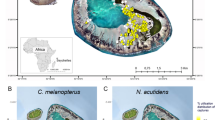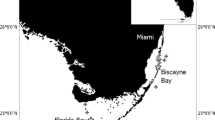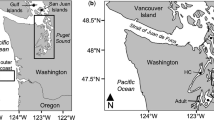Abstract
Carbon and nitrogen stable isotopes (δ13C and δ15N) were used to examine trophic niche dynamics of three co-occurring predators in The Bahamas. Variable estimates of core trophic niche width and total trophic niche overlap were observed between nurse sharks (Ginglymostoma cirratum), southern stingrays (Hypanus americanus), and Atlantic chupare stingrays (Styracura schmardae). Nurse sharks exhibited little trophic overlap with either species of stingray and exhibited higher δ15N values, suggesting limited potential resource competition. Southern and Atlantic chupare stingrays exhibited higher total trophic niche overlap, highlighting higher levels of resource competition. Nurse sharks exhibited the broadest δ13C range, implying utilization of multiple resource pools to facilitate energetic requirements, compared with southern stingrays and Atlantic chupare stingrays. Southern stingrays exhibited the smallest core trophic niche width, highlighting reliance upon a narrower range of resource pools, likely supported by a single habitat type. We postulate that the persistence of the three sub-sampled predator populations is supported by potential resource partitioning and utilization of multiple trophic resource pools. Further information regarding trophic niche dynamics and patterns of resource use is required for data-poor species to identify how populations and communities may respond to the adverse effects of exploitation, such as fisheries impacts, habitat alteration, and pollution.




Similar content being viewed by others
References
Aguiar, A. A., J. L. Valentin & R. S. Rosa, 2009. Habitat use by Dasyatis americana in a south-western Atlantic oceanic island. Journal of the Marine Biological Association of the United Kingdom 89: 1147.
Brooks, E. J., K. A. Sloman, D. W. Sims & A. J. Danylchuk, 2011. Validating the use of baited remote underwater video surveys for assessing the diversity, distribution and abundance of sharks in the Bahamas. Endangered Species Research 13: 231–243.
Brooks, E. J., D. W. Sims, A. J. Danylchuk & K. A. Sloman, 2013. Seasonal abundance, philopatry and demographic structure of Caribbean reef shark (Carcharhinus perezi) assemblages in the north-east Exuma Sound, The Bahamas. Marine Biology 160: 2535–2546.
Burgess, K. B., L. I. Couturier, A. D. Marshall, A. J. Richardson, S. J. Weeks & M. B. Bennett, 2016. Manta birostris, predator of the deep? Insight into the diet of the giant manta ray through stable isotope analysis. Royal Society Open Science 3(11): 160717.
Butchart, S. H., M. Walpole, B. Collen, A. Van Strien, J. P. Scharlemann, R. E. Almond, et al., 2010. Global biodiversity: indicators of recent declines. Science 328: 1164–1168.
Carlisle, A. B., S. Y. Litvin, D. J. Madigan, K. Lyons, J. S. Bigman, M. Ibarra & J. J. Bizzarro, 2017. Interactive effects of urea and lipid content confound stable isotope analysis in elasmobranch fishes. Canadian Journal of Fisheries and Aquatic Sciences 74: 419–428.
Castro, J. I., 2000. The biology of the nurse shark, Ginglymostoma cirratum, off the Florida east coast and the Bahama Islands. Environmental Biology of Fishes 58: 1–22.
Ceballos, G., P. R. Ehrlich, A. D. Barnosky, A. García, R. M. Pringle & T. M. Palmer, 2015. Accelerated modern human–induced species losses: entering the sixth mass extinction. Science Advances 1: e1400253.
Chapman, D. D., E. K. Pikitch, E. Babcock & M. S. Shivji, 2005. Marine reserve design and evaluation using automated acoustic telemetry: a case-study involving coral reef-associated sharks in the Mesoamerican Caribbean. Marine Technology Society Journal 39: 42–55.
Charvet-Almeida, P. & M.P. de Almeida, 2006. Himantura schmardae. The IUCN Red List of Threatened Species 2006: e.T60161A12300074. http://dx.doi.org/10.2305/IUCN.UK.2006.RLTS.T60161A12300074.en. Accessed 27 June 2017.
Compagno, L.J.V., 1984. FAO Species Catalogue. Vol. 4. Sharks of the world. An annotated and illustrated catalogue of shark species known to date. Part 1—Hexanchiformes to Lamniformes. FAO Fish. Synop. 125(4/1):1–249. Rome, FAO.
Craig, H., 1957. Isotopic standards for carbon and oxygen and correction factors for mass-spectrometric analysis of carbon dioxide. Geochimica et Cosmochimica Acta 12: 133–149.
Davidson, L. N., M. A. Krawchuk & N. K. Dulvy, 2016. Why have global shark and ray landings declined: improved management or overfishing? Fish and Fisheries 17: 438–458.
de Young, B., M. Barange, G. Beaugrand, R. Harris, R. I. Perry, M. Scheffer & F. Werner, 2008. Regime shifts in marine ecosystems: detection, prediction and management. Trends in Ecology and Evolution 23: 402–409.
Dulvy, N. K., S. L. Fowler, J. A. Musick, R. D. Cavanagh, P. M. Kyne, L. R. Harrison & C. M. Pollock, 2014. Extinction risk and conservation of the world’s sharks and rays. Elife 3: e00590.
Duplisea, D. E., M. G. Frisk & V. M. Trenkel, 2016. Extinction debt and colonizer credit on a habitat perturbed fishing bank. PloS ONE 11: e0166409.
Elliott, J. E. & K. H. Elliott, 2013. Tracking marine pollution. Science 340: 556–558.
Estrada, J. A., A. N. Rice, L. J. Natanson & G. B. Skomal, 2006. Use of isotopic analysis of vertebrae in reconstructing ontogenetic feeding ecology in white sharks. Ecology 87: 829–834.
Folch, J., M. Lees & G. H. Sloane-Stanley, 1957. A simple method for the isolation and purification of total lipids from animal tissues. Journal of Biological Chemistry 226: 497–509.
Frank, K. T., B. Petrie, J. S. Choi & W. C. Leggett, 2005. Trophic cascades in a formerly cod-dominated ecosystem. Science 308: 1621–1623.
Frisk, M. G., D. E. Duplisea & V. M. Trenkel, 2011. Exploring the abundance–occupancy relationships for the Georges Bank finfish and shellfish community from 1963 to 2006. Ecological Applications 21: 227–240.
Gallagher, A. J., D. S. Shiffman, E. E. Byrnes, C. M. Hammerschlag-Peyer & N. Hammerschlag, 2017. Patterns of resource use and isotopic niche overlap among three species of sharks occurring within a protected subtropical estuary. Aquatic Ecology. https://doi.org/10.1007/s10452-017-9627-2.
Grubbs, R.D., F.F. Snelson, A. Piercy, R. Rosa, & M. Furtado, (2016). Hypanus americanus. The IUCN Red List of Threatened Species 2016: e.T60149A104123038. http://dx.doi.org/10.2305/IUCN.UK.2016-3.RLTS.T60149A104123038.en. Accessed 27 June 2017.
Haas, A. R., T. Fedler & E. J. Brooks, 2017. The contemporary economic value of elasmobranchs in The Bahamas: reaping the rewards of 25 years of stewardship and conservation. Biological Conservation 207: 55–63.
Heithaus, M. R., A. Frid, A. J. Wirsing & B. Worm, 2008. Predicting ecological consequences of marine top predator declines. Trends in Ecology and Evolution 23: 202–210.
Heithaus, M. R., J. J. Vaudo, S. Kreicker, C. A. Layman, M. Krützen, D. A. Burkholder, et al., 2013. Apparent resource partitioning and trophic structure of large-bodied marine predators in a relatively pristine seagrass ecosystem. Marine Ecology Progress Series 481: 225–237.
Hussey, N. E., M. A. MacNeil, J. A. Olin, B. C. McMeans, M. J. Kinney, D. D. Chapman & A. T. Fisk, 2012. Stable isotopes and elasmobranchs: tissue types, methods, applications and assumptions. Journal of Fish Biology 80: 1449–1484.
Jackson, A. L., R. Inger, A. C. Parnell & S. Bearhop, 2011. Comparing isotopic niche widths among and within communities: SIBER–Stable Isotope Bayesian Ellipses in R. Journal of Animal Ecology 80: 595–602.
Kieckbusch, D. K., M. S. Koch, J. E. Serafy & W. T. Anderson, 2004. Trophic linkages among primary producers and consumers in fringing mangroves of subtropical lagoons. Bulletin of Marine Science 74: 271–285.
Kiszka, J. J., A. Aubail, N. E. Hussey, M. R. Heithaus, F. Caurant & P. Bustamante, 2015. Plasticity of trophic interactions among sharks from the oceanic south-western Indian Ocean revealed by stable isotope and mercury analyses. Deep Sea Research Part I: Oceanographic Research Papers 96: 49–58.
Kneitel, J. M. & J. M. Chase, 2004. Trade-offs in community ecology: linking spatial scales and species coexistence. Ecological Letters 7: 69–80.
Knip, D. M., M. R. Heupel & C. A. Simpfendorfer, 2010. Sharks in nearshore environments: models, importance, and consequences. Marine Ecology Progress Series 402: 1–11.
Last, P. R., W. T. White, M. R. de Carvalho, B. Séret, M. F. W. Stehmann & G. J. P. Naylor, 2016. Rays of the world. CSIRO Publishing, Comstock Publishing Associates, Clayton.
Layman, C. A., D. A. Arrington, C. G. Montana & D. M. Post, 2007. Can stable isotope ratios provide for community-wide measures of trophic structure. Ecology 88: 42–48.
Logan, J. M. & M. E. Lutcavage, 2010. Stable isotope dynamics in elasmobranch fishes. Hydrobiologia 644: 231–244.
Mariotti, A., 1983. Atmospheric nitrogen is a reliable standard for natural 15N abundance measurements. Nature 303: 685–687.
Mazerolle, M. J., 2016. AICcmodavg: Model selection and multimodel inference based on (Q)AIC(c). R package version 2.1-0. https://cran.r-project.org/package=AICcmodavg.
McCauley, D. J., H. S. Young, R. B. Dunbar, J. A. Estes, B. X. Semmens & F. Micheli, 2012. Assessing the effects of large mobile predators on ecosystem connectivity. Ecological Applications 22: 1711–1717.
McCauley, D. J., M. L. Pinsky, S. R. Palumbi, J. A. Estes, F. H. Joyce & R. R. Warner, 2015. Marine defaunation: animal loss in the global ocean. Science 347: 1255641.
Moultrie, S., 2012. Master plan for The Bahamas national protected area system. The Nature Conservancy. Northern Caribbean Office, Nassau.
O’Farrell, S., S. Bearhop, R. A. McGill, C. P. Dahlgren, D. R. Brumbaugh & P. J. Mumby, 2014. Habitat and body size effects on the isotopic niche space of invasive lionfish and endangered Nassau grouper. Ecosphere 5: 1–11.
O’Shea, O. R., C. Ward & E. J. Brooks, 2017. Range Extension in Styracura (= Himantura) schmardae (Caribbean Whiptail Stingray) from The Bahamas. Caribbean Naturalist 38: 1–8.
Paine, R. T., 1966. Food web complexity and species diversity. American Naturalist 100: 65–75.
Papastamatiou, Y., C. G. Meyer, R. K. Kosaki, N. J. Wallsgrove & B. N. Popp, 2015. Movements and foraging of predators associated with mesophotic coral reefs and their potential for linking ecological habitats. Marine Ecology Progress Series 521: 155–170.
Pershing, A. J., K. E. Mills, N. R. Record, K. Stamieszkin, K. V. Wurtzell, C. J. Byron, et al., 2015. Evaluating trophic cascades as drivers of regime shifts in different ocean ecosystems. Philosophical Transactions of the Royal Society B 370: 20130265.
Pimm, S. L., 1984. The complexity and stability of ecosystems. Nature 307: 321–326.
Poulakis, G. R., H. Urakawa, P. W. Stevens, J. A. DeAngelo, A. A. Timmers, R. D. Grubbs & J. A. Olin, 2017. Sympatric elasmobranchs and fecal samples provide insight into the trophic ecology of the smalltooth sawfish. Endangered Species Research 32: 491–506.
Rankey, E. C. & S. L. Reeder, 2011. Holocene oolitic marine sand complexes of the Bahamas. Journal of Sedimentary Research 81: 97–117.
Rocha, J., J. Yletyinen, R. Biggs, T. Blenckner & G. Peterson, 2015. Marine regime shifts: drivers and impacts on ecosystems services. Philosophical Transactions of the Royal Society B 370: 20130273.
Rollin, B. E. & M. L. Kessel, 1998. Guidelines for the treatment of animals in behavioural research and teaching. Animal Behavior 55: 251–257.
Rosa, R.S., A.L.F. Castro, M. Furtado, J. Monzini & Grubbs, R.D., 2006. Ginglymostoma cirratum (Western Atlantic subpopulation). The IUCN Red List of Threatened Species 2006: e.T60224A12327471. http://dx.doi.org/10.2305/IUCN.UK.2006.RLTS.T60224A12327471.en.
Shipley, O. N., J. A. Olin, N. V. Polunin, C. J. Sweeting, S. P. Newman, E. J. Brooks, et al., 2017. Polar compounds preclude mathematical lipid correction of carbon stable isotopes in deep-water sharks. Journal of Experimental Marine Biology and Ecology 494: 69–74.
Stehmann, M., J.D. McEachran & R. Vergara R., 1978. Dasyatidae. In W. Fischer (ed.) FAO species identification sheets for fishery purposes. Western Central Atlantic (Fishing Area 31). Vol. 1. [pag. var.]. FAO, Rome.
Stoner, A. W. & J. M. Waite, 1991. Trophic biology of Strombus gigas in nursery habitats: diets and food sources in seagrass meadows. Journal of Molluscan Studies 57: 451–460.
Swanson, H. K., M. Lysy, M. Power, A. D. Stasko, J. D. Johnson & J. D. Reist, 2015. A new probabilistic method for quantifying n-dimensional ecological niches and niche overlap. Ecology 96: 318–324.
Syväranta, J., A. Lensu, T. J. Marjomäki, S. Oksanen & R. I. Jones, 2013. An empirical evaluation of the utility of convex hull and standard ellipse areas for assessing population niche widths from stable isotope data. PloS ONE 8: e56094.
Valentine-Rose, L., C. A. Layman, D. A. Arrington & A. L. Rypel, 2007. Habitat fragmentation decreases fish secondary production in Bahamian tidal creeks. Bulletin of Marine Science 80: 863–877.
Acknowledgements
The authors would like to thank the Cape Eleuthera Foundation and Cape Eleuthera Island School for supporting fieldwork costs. Sample analysis was supported by an NSERC Discovery Grant to Michael Power. Special thanks go to the Shark Research and Conservation Program interns, who provided invaluable field assistance throughout this project. Finally, we would like to thank the anonymous reviewers who helped to strengthen and improve the quality of this manuscript.
Funding
This work was funded by private donations to the Cape Eleuthera Foundation and Cape Eleuthera Institute, and a NSERC Discovery Grant awarded to Michael Power.
Author information
Authors and Affiliations
Corresponding author
Ethics declarations
Conflict of interest
The authors declare no conflict of interest.
Ethical Approval
Research was conducted under permits MAF/FIS/17 and MAF/FIS/13, issued by the Bahamian Department of Marine Resources. Animal care procedures followed the guidelines of the Association for the study of Animal Behaviour and Animal Behavior Society (Rollin & Kessel, 1998).
Additional information
Handling editor: I. A. Nagelkerken
Rights and permissions
About this article
Cite this article
Shipley, O.N., Murchie, K.J., Frisk, M.G. et al. Trophic niche dynamics of three nearshore benthic predators in The Bahamas. Hydrobiologia 813, 177–188 (2018). https://doi.org/10.1007/s10750-018-3523-1
Received:
Revised:
Accepted:
Published:
Issue Date:
DOI: https://doi.org/10.1007/s10750-018-3523-1




